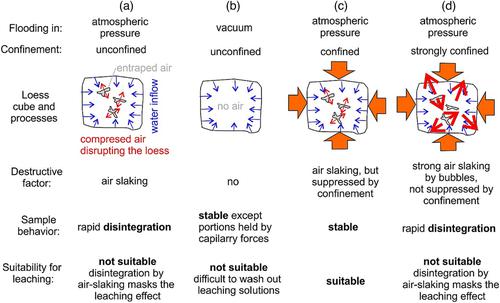当前位置:
X-MOL 学术
›
Earth Surf.Process. Land.
›
论文详情
Our official English website, www.x-mol.net, welcomes your feedback! (Note: you will need to create a separate account there.)
Loess susceptibility to erosion: Interaction of cohesion sources, air slaking and confinement
Earth Surface Processes and Landforms ( IF 3.3 ) Pub Date : 2024-02-24 , DOI: 10.1002/esp.5800 Jan Vojtíšek 1 , Jiří Bruthans 1
Earth Surface Processes and Landforms ( IF 3.3 ) Pub Date : 2024-02-24 , DOI: 10.1002/esp.5800 Jan Vojtíšek 1 , Jiří Bruthans 1
Affiliation

|
Erosion in loess is a widespread phenomenon, as loess covers about 10% of the Earth's land surface. While erosion of loess soil has been intensively studied, the mechanisms controlling erosion in gullies and pipes in loess are poorly understood. Cohesion plays an important role in erosion in loess. Interactions between erosional processes and stabilizing mechanisms in loess are poorly understood. This study focuses on the interaction between air slaking and stabilization by confinement to improve leaching techniques for identifying cohesion sources in undisturbed loess from four sites in Czechia. The decrease in tensile strength of samples after leaching in distilled water, dithionate, HCl, and hydrogen peroxide was used to selectively remove cohesion sources such as Fe‐Al oxides and hydroxides, carbonates, and organic matter. Experiments showed that confinement and overburden stress are important but neglected stabilizing mechanisms in loess. Leaching of unconfined loess samples gave misleading results because of ubiquitous air slaking. To reliably identify cohesion sources, samples confined in compacted sand were used. Leaching of confined samples showed that Fe‐Al oxides and hydroxides are major sources of cohesion (60–90%), while carbonates and organic matter are of minor importance (0–30%). To avoid misleading results, examination of loess structure after leaching is critical to identify samples with damaged structure due to enhanced air slaking caused by bubbles generated during leaching. Air slaking is a powerful and rapid damage mechanism, but it occurs only in dry or semi‐dry loess near the soil surface. In contrast, chemical weathering is able to remove cohesion sources in deeper parts of the loess profile.
中文翻译:

黄土对侵蚀的敏感性:粘聚力源、空气熟化和限制的相互作用
黄土侵蚀是一种普遍现象,黄土覆盖了地球陆地表面的约 10%。尽管人们对黄土侵蚀进行了深入研究,但对黄土中沟渠和管道侵蚀的控制机制知之甚少。粘聚力在黄土侵蚀过程中起着重要作用。人们对黄土侵蚀过程和稳定机制之间的相互作用知之甚少。本研究的重点是空气熟化与限制稳定之间的相互作用,以改进浸出技术,以识别捷克四个地点的原状黄土中的粘聚力来源。利用蒸馏水、连二硫酸盐、HCl 和过氧化氢浸出后样品拉伸强度的下降来选择性去除粘结源,如 Fe-Al 氧化物和氢氧化物、碳酸盐和有机物。实验表明,约束和覆盖应力是黄土中重要但被忽视的稳定机制。由于普遍存在空气熟化,无约束黄土样品的浸出给出了误导性的结果。为了可靠地识别内聚力来源,使用了封闭在压实砂中的样品。密闭样品的浸出表明,Fe-Al 氧化物和氢氧化物是凝聚力的主要来源(60-90%),而碳酸盐和有机物的重要性次要(0-30%)。为了避免误导结果,浸出后检查黄土结构对于识别由于浸出过程中产生的气泡导致空气熟化增强而导致结构受损的样品至关重要。空气熟化是一种强大而快速的破坏机制,但它只发生在靠近土壤表面的干燥或半干燥黄土中。相比之下,化学风化能够消除黄土剖面较深处的粘聚源。
更新日期:2024-02-24
中文翻译:

黄土对侵蚀的敏感性:粘聚力源、空气熟化和限制的相互作用
黄土侵蚀是一种普遍现象,黄土覆盖了地球陆地表面的约 10%。尽管人们对黄土侵蚀进行了深入研究,但对黄土中沟渠和管道侵蚀的控制机制知之甚少。粘聚力在黄土侵蚀过程中起着重要作用。人们对黄土侵蚀过程和稳定机制之间的相互作用知之甚少。本研究的重点是空气熟化与限制稳定之间的相互作用,以改进浸出技术,以识别捷克四个地点的原状黄土中的粘聚力来源。利用蒸馏水、连二硫酸盐、HCl 和过氧化氢浸出后样品拉伸强度的下降来选择性去除粘结源,如 Fe-Al 氧化物和氢氧化物、碳酸盐和有机物。实验表明,约束和覆盖应力是黄土中重要但被忽视的稳定机制。由于普遍存在空气熟化,无约束黄土样品的浸出给出了误导性的结果。为了可靠地识别内聚力来源,使用了封闭在压实砂中的样品。密闭样品的浸出表明,Fe-Al 氧化物和氢氧化物是凝聚力的主要来源(60-90%),而碳酸盐和有机物的重要性次要(0-30%)。为了避免误导结果,浸出后检查黄土结构对于识别由于浸出过程中产生的气泡导致空气熟化增强而导致结构受损的样品至关重要。空气熟化是一种强大而快速的破坏机制,但它只发生在靠近土壤表面的干燥或半干燥黄土中。相比之下,化学风化能够消除黄土剖面较深处的粘聚源。



























 京公网安备 11010802027423号
京公网安备 11010802027423号